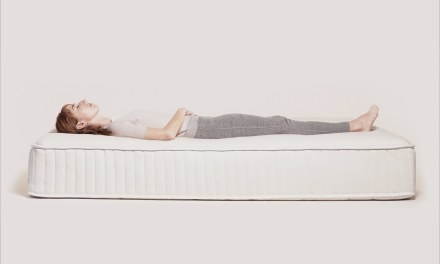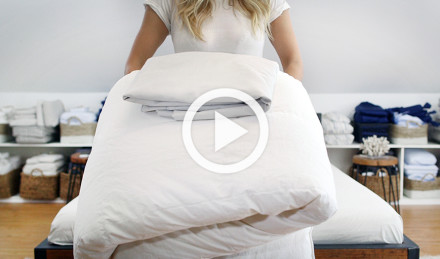There's no right or wrong way to doze off — the choice of position is a personal one. And yet, like many others who prefer the lateral sleep position, you might be wondering, Is sleeping on your side bad?
It's definitely not bad to slumber on your side. In fact, you'll be glad to hear that many consider side sleeping the best option — the other two being back and stomach. In that case, what side should you sleep on?
Read on for a research-backed answer to this question, along with insight into the various benefits of being a side sleeper, potential drawbacks and thoughtful tips on how to sleep on your side to achieve your most restorative rest.
Side Sleepers: Who Are They?
Side Sleepers: Who Are They?
Research suggests that a slight majority of adults sleep on their sides. According to a study published in the journal Nature and Science of Sleep, about 54% snooze on their sides, 38% are back sleepers and roughly 8% slumber on their stomachs. More specifically, 55% of side sleepers keep an arm over their head, and many bend one leg up toward their chest.¹
Kids sleep on their sides, backs and fronts about equally, and begin trending toward side sleeping as they get closer to adulthood. And even into adulthood, the lateral preference continues to increase with age.²
Side sleeping is often recommended during pregnancy. One study published in the journal Society for Cardiovascular Magnetic Resonance found that from about 20 weeks on, this position can encourage blood flow to the fetus.³ As with all sleeping positions, folks often choose the side simply because they find it to be the most comfortable.
Pros and Cons of Side Sleeping
If you're the type of person who strives to optimize all aspects of life, you've probably thought about how to achieve your healthiest, most restful sleep. With that said, it's worth considering the pros and cons of being a side sleeper before getting into how to sleep on your side.
Benefits of Sleeping on Your Side
Pros and Cons of Side Sleeping
If you're the type of person who strives to optimize all aspects of life, you've probably thought about how to achieve your healthiest, most restful sleep. With that said, it's worth considering the pros and cons of being a side sleeper before getting into how to sleep on your side.
Benefits of Sleeping on Your Side
There's a reason a majority of adults are side sleepers. In fact, there are many reasons. Find a rundown of the various benefits below.
Reduced Snoring and Sleep Apnea
Back sleepers are more prone to snoring than stomach and side sleepers. Moreover, loud snoring is associated with sleep apnea, a sleep disorder in which someone periodically stops and then restarts breathing.⁴ Not only does the side position reduce snoring, but it can also help keep the airways open and prevent sleep apnea.⁵
Pain and Strain Relief
People with chronic pain in their lower backs and necks — as well as those who often wake up with strained muscles — might find relief from lying on their side. Sleeping on the stomach or back can put extra pressure on the spine, which could be a culprit of pain, stiffness and discomfort.⁶
Improved Digestion
Side sleepers might also enjoy digestive benefits. A clinical trial showed that it takes longer for gas to leave the digestive system when lying on the back.⁷ So those experiencing bloating, constipation and other gastrointestinal issues may find relief in the lateral position.
Reduced Heartburn
Heartburn is technically a digestive issue. However, it's important to highlight it on its own, since acid reflux can worsen when lying in the wrong position. Lots of folks (including pregnant people) find that sleeping on the left side significantly reduces heartburn symptoms.⁸
Better Brain Health
If digestive function, pain relief and reduced snoring aren't enough, get this: side sleepers might benefit from better brain health. The brain rids itself of waste at all hours, but most of the cleansing happens at night. Researchers at Stony Brook University found that the side position helps the waste removal process go faster than dozing on your stomach or back.⁹
Potential Drawbacks of Sleeping on Your Side
As mentioned above, laying on the left side can help alleviate heartburn. However, sleeping on the right side might worsen symptoms, especially for pregnant folks and those with GERD (gastroesophageal reflux disease).⁶
No two bodies are the same. While some people will be relieved from discomfort, others may experience pain from sleeping on their sides. Having said that, side sleepers with hip or shoulder strain can make it work with the right pillow, mattress and position adjustments.⁶
People who catch Zs on their stomach or side may also wake up with creases on their face and chest, though this may not be an issue with a smooth pillowcase. (Specific product recommendations for how to sleep on your side can be found below).
Should I Sleep on Left or Right Side?
When discussing how to sleep on your side, it's crucial to touch on what side to sleep on. So, which is better, left or right? Though both sides can offer benefits like reduced snoring and pain relief, the left is typically considered superior.
Why the Left Side Is [Usually] the Best Side
While left vs right depends on each sleeper and their unique needs, the best side to sleep on is usually the left. According to research published in The American Journal of Gastroenterology, people who lay on the left side tend to experience fewer acid reflux symptoms.¹⁰
As noted, left-side sleeping is recommended for pregnancy, as it helps with circulation to the fetus, plus it takes weight from the uterus off the liver. Even for those who aren't expecting, some experts believe the left side is comfortable because it takes pressure off right-side organs, like the liver, pancreas and intestines.¹¹
All that said, lots of people switch between sides throughout the night. Moving from left to right might minimize creases on your face and chest too.
Should I Sleep on Left or Right Side?
When discussing how to sleep on your side, it's crucial to touch on what side to sleep on. So, which is better, left or right? Though both sides can offer benefits like reduced snoring and pain relief, the left is typically considered superior.
Why the Left Side Is [Usually] the Best Side
While left vs right depends on each sleeper and their unique needs, the best side to sleep on is usually the left. According to research published in The American Journal of Gastroenterology, people who lay on the left side tend to experience fewer acid reflux symptoms.¹⁰
As noted, left-side sleeping is recommended for pregnancy, as it helps with circulation to the fetus, plus it takes weight from the uterus off the liver. Even for those who aren't expecting, some experts believe the left side is comfortable because it takes pressure off right-side organs, like the liver, pancreas and intestines.¹¹
All that said, lots of people switch between sides throughout the night. Moving from left to right might minimize creases on your face and chest too.
How to Optimize Your Side Sleeping Experience
As a side sleeper, there are a handful of things you can do to make your shut-eye all the more comfortable and restorative. Read on for helpful tips and useful guidance on how to sleep on your side properly.
How to Sleep on Your Side: Getting Into Position
In terms of spinal alignment and circulation, it's best to aim for a symmetrical side sleeping position. By adhering to the natural curve of your spine, you might wake up to fewer aches and pains.¹¹
Here's how to get into position:
Lying on your side with your head resting on a pillow, look straight ahead so that your chin isn't tilted down toward your neck.
Keep your legs and knees in the same position, whether at an angle, slightly bent or straight. (Placing a pillow between your knees can help alleviate pressure on your hips.)
Try to keep your arms aligned, either straight down at your sides or in front of your chest with your elbows bent.
Some side sleepers are partial to the fetal position, meaning the legs are curled up toward the chest. If this is your forte, just try not to curl too tight, as it might restrict your breathing.¹¹
How to Sleep on Side Without Hurting Your Shoulder
Shoulder pain is sometimes a concern for side sleepers. The best way to avoid this is to keep your head in a neutral position, so your neck is positioned right in between your shoulders. Additionally, make sure your shoulders are in line with your hips, as opposed to twisted at an angle. Alternating between your left and right sides may also help.¹¹
Bed Essentials for Side Sleepers
High-quality bedding essentials make a world of difference when it comes to getting a good night's rest. As a side sleeper, you'll want to look for pillows, bed linens and a mattress that accommodate your preferred position. Read on for specific product recommendations.
Thick, Supportive Bed Pillow
Research has shown that a thick, supportive pillow is ideal for side sleepers. The idea is that a thicker pillow encourages proper alignment all the way down your spine and minimizes pressure on your neck.¹²
Look for a medium-density side sleeper pillow with a 3–4-inch gusset. Either down or down alternative fill will work, as long as you have the thickness.
Read these blogs for more insight into selecting a bed pillow:
Pillow Guide: How to Choose the Right Pillow
Down vs. Down Alternative: A Comparison Guide
Smooth, Breathable Pillowcase
How to Optimize Your Side Sleeping Experience
As a side sleeper, there are a handful of things you can do to make your shut-eye all the more comfortable and restorative. Read on for helpful tips and useful guidance on how to sleep on your side properly.
How to Sleep on Your Side: Getting Into Position
In terms of spinal alignment and circulation, it's best to aim for a symmetrical side sleeping position. By adhering to the natural curve of your spine, you might wake up to fewer aches and pains.¹¹
Here's how to get into position:
Lying on your side with your head resting on a pillow, look straight ahead so that your chin isn't tilted down toward your neck.
Keep your legs and knees in the same position, whether at an angle, slightly bent or straight. (Placing a pillow between your knees can help alleviate pressure on your hips.)
Try to keep your arms aligned, either straight down at your sides or in front of your chest with your elbows bent.
Some side sleepers are partial to the fetal position, meaning the legs are curled up toward the chest. If this is your forte, just try not to curl too tight, as it might restrict your breathing.¹¹
How to Sleep on Side Without Hurting Your Shoulder
Shoulder pain is sometimes a concern for side sleepers. The best way to avoid this is to keep your head in a neutral position, so your neck is positioned right in between your shoulders. Additionally, make sure your shoulders are in line with your hips, as opposed to twisted at an angle. Alternating between your left and right sides may also help.¹¹
Bed Essentials for Side Sleepers
High-quality bedding essentials make a world of difference when it comes to getting a good night's rest. As a side sleeper, you'll want to look for pillows, bed linens and a mattress that accommodate your preferred position. Read on for specific product recommendations.
Thick, Supportive Bed Pillow
Research has shown that a thick, supportive pillow is ideal for side sleepers. The idea is that a thicker pillow encourages proper alignment all the way down your spine and minimizes pressure on your neck.¹²
Look for a medium-density side sleeper pillow with a 3–4-inch gusset. Either down or down alternative fill will work, as long as you have the thickness.
Read these blogs for more insight into selecting a bed pillow:
Pillow Guide: How to Choose the Right Pillow
Down vs. Down Alternative: A Comparison Guide
Smooth, Breathable Pillowcase
To keep skin creases at a minimum, choose a pillowcase made of a smooth fabric like sateen or silk.
Since half your face will be up against the pillow, airflow and moisture-wicking properties are key for avoiding night sweats. Silk pillowcases are made from premium mulberry silk and are famous for their luxurious softness and breathability. Sateen pillowcases are woven from long-staple Egyptian cotton, making them a naturally breathable and absorbent option as well.
Learn more about these ultra-smooth fabrics and how to select a pillowcase with these guides:
Sateen: Know Your Bedding Like a Designer
Sateen vs. Satin vs. Silk: What's the Difference?
Pillowcase and Sham Guide: How to Choose the Best Options for Your Bedroom
Body Pillow
Lots of folks find that a body pillow makes side sleeping all the more comfortable. If you experience hip strain or have a hard time getting into a symmetrical position, a body pillow might be an effective solution.
Supportive, Medium-Firm Mattress

A study published in the journal Applied Ergonomics found that medium-firm mattresses are ideal for side sleepers in terms of sleep quality, pain reduction and overall comfort.¹³ Softer mattresses, on the other hand, might make your hips and shoulders sink down. This could result in aches and pains come morning and potentially create alignment issues.
Consider the Eco Mattress from Parachute. It's firmer in the middle to support the back, and softer at the head and feet to promote proper alignment and relieve pressure points throughout the body.
Check out these articles to find out how the Eco Mattress stacks up against other models:
The Eco Mattress: Everything You Need to Know
A Decision-Making Guide for Buying the Right Mattress
Breathable Bedding
Breathable bedding is essential for every type of sleeper. Since it encourages airflow and wicks away moisture without trapping heat, breathable fabric helps regulate your body temperature and minimizes night sweats.
This is particularly significant for side sleepers. Why? When you remain at a comfortable temperature and don't sweat excessively, you're more likely to stay in a symmetrical position. What's more, you can expect to wake up fewer times throughout the night, which is critical for quality shut-eye.
When buying sheets, pillowcases, a duvet cover and other bed linens, opt for naturally-sourced fabrics. The most breathable options include brushed cotton, percale, sateen and linen.
Read these guides for a deeper dive into Parachute's all-star textiles:
Fabric and Bedding Materials Guide
How to Pick Bed Sheets Based on How You Sleep: Buying Guide
Where to Buy the Best Sleeping Essentials
Now that you're up to speed on how to sleep on your side, you're ready to put these ideas into motion. Parachute has all the essentials for achieving your best night's sleep yet. From naturally breathable bed linens and an exceedingly comfortable medium-firm mattress to side sleeper pillows and body pillows, you'll find everything you need. Browse the collections today!
Read Next:
Guide to Quilts, Blankets and Coverlets: A Modern Take on Traditional Covers
What Is a Top Sheet? Do You Actually Need One?
The 14 Best Plants for Bedrooms
The Baby Collection: Behind the Design
What Is Long-Staple Egyptian Cotton?
Linen: Know Your Bedding Like a Designer
Brushed Cotton: Know Your Bedding Like a Designer
Percale: Know Your Bedding Like a Designer
What Is Oeko-Tex? Learn About This Textile Certification Standard
How Often to Replace Sheets, Pillows and Other Bed Linens
31 Bedroom Color Trends and Inspiration
37 Bedroom Decorating Ideas You'll Love
External Sources:
1. https://www.ncbi.nlm.nih.gov/pmc/articles/PMC5677378/
2. https://pubmed.ncbi.nlm.nih.gov/1579788/
3. https://pubmed.ncbi.nlm.nih.gov/21708015/
4. https://www.mayoclinic.org/diseases-conditions/sleep-apnea/symptoms-causes/syc-20377631
5. https://onlinelibrary.wiley.com/doi/abs/10.1002/ejhf.410
6. https://www.hopkinsmedicine.org/health/wellness-and-prevention/choosing-the-best-sleep-position
7. https://pubmed.ncbi.nlm.nih.gov/12801953/
8. https://pubmed.ncbi.nlm.nih.gov/8071510/
9. https://www.sciencedaily.com/releases/2015/08/150804203440.htm
10. https://pubmed.ncbi.nlm.nih.gov/10445529/
11. https://www.sleepfoundation.org/sleeping-positions/side-sleeping








